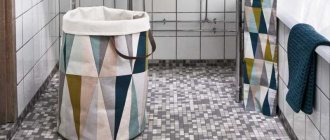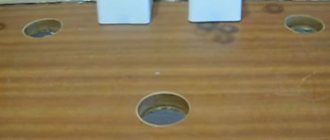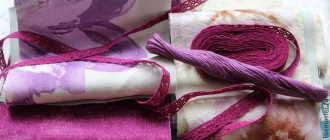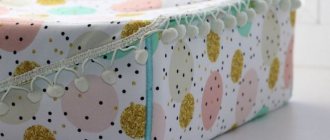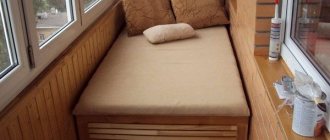- The simplest stationary driver
It is hardly possible to live in an apartment without a device for drying clothes. Such designs are not cheap, so the question of how to make a clothes dryer with your own hands is very relevant. Next, we’ll tell you in more detail about how to make a practical device using available materials.
Today, drying clothes in the house is a common occurrence.
Optimal conditions for drying clothes
Owners of private houses in the village dry clothes the old fashioned way. They hang it on ropes stretched in the yard between two supports. The natural drying method is considered the most optimal. This is confirmed by a number of advantages:
- When drying naturally, the laundry does not dry out and is saturated with oxygen. On the street, toxic fragrances from washing powders erode. Linen brought in from the cold smells fresh, but dried items indoors may have a musty smell.
- Outside, especially in warm weather, laundry dries faster. This happens due to wind blowing. Moisture from the fabric evaporates faster.
- Laundry drying outside does not harm a person. If you do this indoors, fungus appears on the walls from the evaporating moisture. In addition, all family members living in the house breathe these fumes, which contain particles of washing powder.
Outdoor conditions are considered the most optimal for drying clothes, but they are not always available. The obstacle is inclement weather or the lack of a private yard for the person living in the apartment.
Devices in the form of different grid configurations help dry laundry indoors
If it is impossible to use outdoor conditions, drying clothes is moved indoors. They come up with various devices in the form of gratings. However, here too you need to think about the optimal location for them. Ideal conditions on the balcony. Here, moisture evaporation is not dangerous for living family members. Even if the balcony is glazed, opening the windows can create a draft to speed up drying.
If you exclude the balcony, then it is optimal to place the dryer indoors near the radiator. Warm air causes moisture to evaporate faster. However, the bedroom will not do. In the hall, drying laundry spoils the interior. It is optimal to place the dryer near the radiator, where it is least visible, for example, in the bathroom or kitchen.
An indispensable assistant in the apartment
“Grandma’s” methods of drying clothes on an unglazed balcony or in the courtyards of high-rise buildings are happily a thing of the past. Most people prefer to dry things in apartments on special dryers, where they can place a sufficient amount of laundry and at the same time save space. Modern dryers are a practical interior detail, as well as an air humidifier.
Criteria for choosing a clothes dryer
First, decide which dryer is right for you. The choice of dryer depends on the following parameters:
- Volume of laundry. Assess how often you wash and how much laundry you dry. The more kilograms of wet laundry, the larger and stronger the dryer you need. It is better to initially choose a dryer that is suitable for you than to repair or replace it later. The length of the structure and the supported weight of the laundry are indicated on the packaging.
The dryer packaging contains important information: rod length, permissible laundry weight
- Mobility and fastening. Consider whether you want to move the dryer every now and then or whether your laundry will always dry in the same place. For example, if you live in a rented apartment, where the hammering of each nail must be agreed upon with the owner.
- Material and cost. The stronger, more trouble-free and durable the material of the dryer, the more expensive it is. Modern dryers are made from 4 materials - plastic, steel, stainless steel and aluminum. The cheapest ones are plastic and aluminum, they are also the most short-lived - plastic is deformed under the influence of temperature, and aluminum after a while can leave irremovable stains on your things. Steel is susceptible to corrosion even when protective coatings are applied. So the most suitable material for a dryer is stainless steel. Unfortunately, these models are more expensive than others.
Photo gallery: clothes dryers made of various materialsaluminum dryer
Plastic dryers often break due to the fragility of the material.
Metal dryers are undeniably durable, but they will rust over time.
Stainless steel dryers are expensive, but will not cause trouble to use
When choosing a dryer, you should also pay attention to the manufacturer. Popular dryers are from Leifheit (made in the Czech Republic), Gimi (Italy), Nika (Izhevsk), Lakmet (Kirov). According to user reviews, you should not choose models made in China: as a rule, they are made of low-quality material and do not last long.
Please note that only wrung-out laundry can be hung on any dryer. If you wash by hand, first let the water drain from the items or place a container of water under the dryer.
Types of dryers
Special devices have been invented for drying clothes - dryers. Another name for them is dreyers. They are a lattice made of rods or ropes. Factory-made products are conventionally divided into two groups: stationary and portable. Dryers of the first type are permanently installed in one place where they create the least amount of interference. Usually they choose a balcony or a bathroom. Portable dryers can be placed anywhere, and after the clothes are finished drying, they are stored in the pantry.
Dryers are divided by type of location:
- Floor-standing models are usually all portable. Install them on legs.
- Stationary wall models. They can be sliding, folding or in the form of a one-piece structure.
- Ceiling models are similarly classified as stationary. Most dryers consist of a series of brackets and ropes.
- Wall-ceiling models have two mounting points: to the ceiling with brackets, and to the wall with a special bracket.
To assemble a clothes dryer with your own hands, no drawings are required. Homemade designs are no different from factory-made analogues. It is enough to visually inspect the dryer once and copy the design without any drawings.
To better understand the types of drayers, it’s worth taking a closer look at them:
- Portable dryers have many modifications. Horizontal models take up a lot of space. It is more convenient to take them outside or place them indoors where there is a lot of free space. Vertical models are convenient for apartments where space is limited. However, laundry takes longer to dry on them, since due to the close arrangement, ventilation is reduced. Fixed mini-dryers are mounted on a radiator or bathtub. After drying the clothes, remove them. Important! Portable electric models are convenient for quickly drying washed items, but it is difficult to assemble such a structure at home. Most often, factory dryers are found; they are made of stainless steel tubes, inside of which a heating element is placed. On a horizontal dryer, laundry dries faster due to better ventilation, but takes up useful space in the room
- If you decide to make a wall-mounted clothes dryer yourself, the easiest way is to go with a non-folding option. The structure has supports attached to opposite walls. Cords are stretched between them or thin tubes are installed. Craftsmen can copy a factory-made folding drayer. An inertial dryer is popular, in which the ropes are wound onto a shaft due to a spring mechanism. Another popular type of dreyer is the accordion. It consists of a set of tubes movably connected to each other by plates. The inertial dryer and the accordion have restrictions on the weight of the hanging laundry
- Among ceiling fixtures, the structure most often made is the type of hanging vine. It consists of two brackets attached to the ceiling. Holes are drilled in them through which a cable is pulled for hanging and adjusting the height of the tubes; laundry is hung on them. Ceiling model is convenient on the balcony
Wall-ceiling type dryers are less popular in DIY production. Not every owner wants to drill simultaneously into the ceiling and wall lining for brackets and brackets.
What types of designs are there?
An outdoor dryer must be massive and strong. Hanging laundry in a gusty wind creates a sail effect and can fly off the cord. For outdoor use, wall and ceiling models of stationary dryers, as well as homemade ones, are used.
Clothes on the dryer must be secured with clothespins.
Attach the fabric to the slats using wooden or plastic clothespins. They do not leave marks even on light-colored materials.
An outdoor dryer must be well secured.
Homemade
You can find a way out of any situation. Even if the need to hang up wet clothes finds you far from home, a homemade laundry dryer will come to the rescue. Basic models are created from improvised materials, pipes, wooden slats and even reels of thick cardboard. It is especially convenient if there are already pillars or piles built into the ground:
- any structure driven into the ground in the shape of the letter “P” turns into an excellent assistant for drying things;
- It is enough to stretch a few strong cords between the T-shaped crossbars so that you can dry any wet clothes.
Ready-made designs
Ready-made structures are divided into stationary and mobile. The first ones are massive and can withstand strong winds and any bad weather. The latter can be removed or folded as unnecessary. Mobile, transforming models are made of durable but lightweight materials that can be cleaned from dust and dirt.
How to make your own clothes dryer
Before starting the manufacture of a stationary drayer, first select the place where it will be installed. Its size and design depend on this. If you decide to make a portable clothes dryer outdoors, you don’t have to be limited in size. However, it is important to consider that in bad weather you may have to use the device inside the house. For this reason, it is still worth paying attention to the dimensions.
Tools and materials
First of all, the material is prepared for the work. Strict requirements are imposed on him. After washing, the laundry is hung out damp. The dryer material should not release coloring substances upon contact with water. It is important that there are no roughness or burrs, otherwise there will be puffs and abrasions on the linen.
Of the available materials at hand, most often you have:
- Metal tubes. The frame will be strong, but there are many nuances. Tubes made of ferrous metal should absolutely not be used even if painted. They rust and leave stains on the laundry. Aluminum, copper, and brass tubes are resistant to corrosion, but they are soft and can withstand the light weight of the laundry. In addition, they are difficult to connect with each other. If you rub laundry over the tubes, a small mark will still remain. Stainless steel is the ideal choice. The frame will be durable and will not rust from contact with water. Stainless steel tubes are the best material for drayers
- Plastic tubes. The material is resistant to corrosion, and this is its only advantage. It is impossible to hang a lot of laundry on a plastic tube, as it bends.
- Wooden slats. The natural material is easy to process. However, upon contact with water, the wood collapses and turns black. The emerging fungus will leave dirty stains on the laundry. It is optimal to make the body of the dryer from wood. For underwear jumpers, it is better to choose a different material.
- Rope and wire. These two materials are the most popular for dryers. Ropes are made from artificial thread; natural ones are not suitable. The wire is chosen with a galvanized coating.
Based on the results of the review, we can conclude that it is optimal to make your own clothes dryer from stainless steel, wood, wire and rope. If you resort to a trick, a plastic tube will do. To make it rigid, a metal rod is inserted inside.
The tool is selected for a specific material. You will need a grinder, a saw, an electric drill with a set of drills, a tape measure, and a pencil.
The tool will be needed not only to assemble the dryer, but also to hang it on the wall or ceiling
If the drayer is not portable, it will need to be fixed to the ceiling or wall. You will need dowels, brackets, and anchor bolts. You will need a hammer, pliers, and wrenches.
Each material has its own method of fastening. Stainless steel tubes are connected by electric welding. Wood requires self-tapping screws or bolts.
What material is suitable for manufacturing
Before you start making a clothes dryer, you need to decide on the material of the product. The choice is quite large:
- Aluminum is the lightest of metals, but it is also quite fragile. This means that a drying device designed for a large amount of clothes and linen should not be made of aluminum parts. In addition, making a frame from aluminum pipes is quite problematic.
- Stainless steel is the optimal choice for powerful drying products designed for large families. The only drawback of this metal is its heavy weight. The structure must be mounted on a wall or ceiling very securely, since standard hooks may not be able to support the large mass of clothing along with the frame. It is better for beginners to refrain from using this material for making ceiling dryers themselves.
- Plastic (PVC) is a lightweight and easy-to-process material, but it is also quite fragile. Suitable only for those dryers on which few things will be dried (up to 5 kg). Another positive feature is that it does not corrode when exposed to moisture.
- Wood is an easy-to-work natural material that is also very affordable. Since wooden products are destroyed by moisture, it is necessary to coat the product with a double layer of water-repellent paint or varnish before use.
Profiles made of aluminum, stainless steel, plastic and wooden blocks from which dryers can be made
Before you design the structure and start manufacturing it, decide on the size and weight of the things you are going to dry. Count on approximately 5-6 kg of wet items per family member. Accordingly, for a family of three people you will need a device that can withstand up to 18 kg of weight.
Metal lifting structure for drying things installed on the balcony
The optimal places to place dreyers are bathrooms, balconies and loggias. Do not forget that water can drain from wet things onto the floor, so it is impractical to install drying structures in residential areas.
How to make clothes lines for drying clothes
The simplest rope dryer can be made in a couple of hours. It will require a minimum of materials. You just need to find a free corner in the house where it won’t interfere.
The essence of the design is to fix fasteners for ropes on opposite walls. First, prepare two boards. Their length will determine the width of the drayer. The boards are secured with dowels and screws to opposite walls.
For a rope dryer indoors, choose an empty corner
Metal loops for ropes are screwed into the fixed boards. Special anchors will be used for this. On one side they have a ring, and on the other end there is a thread like a self-tapping screw. The anchor is simply screwed into the board by hand. When all the elements are installed, a strong artificial cord is passed through the rings, pulled tight and secured with knots.
Using a similar principle, they make their own clothes dryer on the street, choosing the walls of neighboring buildings as supports. You can simply dig in posts with jumpers in the shape of the letter “P” or “T” and stretch ropes between them.
Advice! Instead of ropes, galvanized wire 2-3 mm thick is suitable.
Making tool
To make a clothes dryer yourself, the master must have the following tools:
- impact drill;
- screwdriver;
- sets of Phillips and flat screwdrivers;
- roulette;
- a hacksaw for wood (if the material for production is wood);
- a hacksaw for metal (if you are going to make a drayer from aluminum, stainless steel or plastic);
- sets of drills, dowels and screws.
Carpenter's tools for woodworking
How to make a clothes dryer out of aluminum on the balcony
Aluminum tubes cannot be joined by conventional welding. When you want to assemble a dryer from this particular material, you should take a different path. First, the installation location is determined. Usually they use a balcony, where it occupies a certain space.
Aluminum tubes move freely along the profile grooves
On opposite walls, lines are marked along the width of the brackets for the future structure. Take an aluminum profile with an internal width between the side shelves of 10 mm. Saw off to size of the workpiece. These will be the brackets. They are fastened to the wall with dowels strictly according to the markings. The profile slot is directed towards the front side, that is, away from the wall.
Using a tape measure, measure the exact distance between the two walls. Tubes are cut. They should fit freely into the profile slots. If they do not fit in length, shorten them a little. The tubes will be securely held in the slots of the profiles, but heavy laundry should not be hung. Aluminum is a soft metal and bends under load. A bent tube can fall out of the groove and the laundry will end up on the floor.
Homemade drying rack from hangers
Materials:
- an old curtain rod along with the rings, fasteners and plugs on it;
- hangers;
- screws assembled with dowels.
Progress:
- Inspect the cornice mounting system and make appropriate marks on the ceiling.
- Drill holes according to the marks, insert dowels and screw the cornice to them with self-tapping screws.
- Hang the hangers on the curtain rings and secure the joints with electrical tape.
DIY Folding Wall Clothes Drying Rack
To ensure that the dryer attached to the wall does not interfere, fold it optimally after drying the laundry. There are many options for folding designs. The simplest is the folding model.
Of all the folding options, the easiest way to make a folding dryer for the wall
Assemble a clothes dryer with your own hands from wood, since this material is the easiest to build a rectangular frame from. Jumpers for hanging linen can be inserted from a different material. A plastic, stainless or aluminum tube will do.
The finished structure looks like a ladder. In order for the drayer to recline, the frame is attached to the wall with hinges from below. The upper side is secured with rods made of a thin chain or strong cord. The length is selected individually, taking into account the angle at which the ladder should deviate from the wall. Additionally, in the upper part, a latch is attached to the frame, and a counter plate is attached to the wall. The latch will hold the dryer in the folded position.
Types of dryers depending on location
Ready-made kits are varied, but even among such an assortment, the most successful designs can be distinguished.
Mobile dryers
The main “trump card” of such products is the ability to move and change position. This is very convenient for small rooms, when every centimeter of space is distributed, and there is not enough space for a full-size hanging model. Also, such dryers will help out the guests of rented housing, because the installation of the hanging structure must be discussed in advance with the owners.
DIY folding outdoor clothes dryer
The assembly of folding structures is more difficult due to the need to create moving units. However, there is a way out of any situation. You will need an old umbrella with strong, unbroken spokes. The fabric part does not matter what condition it is in. It is immediately cut off. The umbrella skeleton is used for hanging light laundry.
You can dry light items on the umbrella spokes
This option is convenient when you need to make a clothes dryer outside the window of an apartment building. The umbrella, in an inverted state, is tied by the handle to a protruding rail fixed on the window sill. If there is a tall tree nearby and you can reach a branch from the window, this is also a good support for hanging a folding drayer.
What are the criteria for choosing a dryer?
Before you start choosing a dryer, decide how much laundry you will dry at one time.
Linen volume
It must be calculated based on the load of the washing machine and the number of washes performed at a time. For a large family, you should choose a model that can withstand a maximum weight of 20-30 kg; for a family of 3-4 people, 15 kg will be enough; for one person, you can limit yourself to 5-10 kg.
The useful length of the ropes or drying rods matters. It can be 1.5 meters for some wall-mounted ones, and up to 20 meters for exhaust ones.
These characteristics depend on the design, method of fastening and material of manufacture.
There are several ways to attach dryers, which allows you to choose the most convenient option. First of all, decide where it will be installed.
Where can it be mounted: floor racks, wall brackets, window options, etc.
- the floor can be placed in any free space and, if necessary, moved to another place;
- wall-mounted is permanently attached to one or two walls, always ready for use;
- the ceiling without linen is completely invisible, does not take up useful space, and can withstand a large volume of laundry;
- wall-ceiling or vine - the most popular option with adjustable height of individual rods;
- other types: with attachment to a radiator, a bathtub, hanging nets for delicate items - convenient as additional ones to the main dryer.
When making a choice, pay attention to some design features
Design features
At first glance, dryers may not differ from each other. But some models are equipped with useful features that will make them easier to use and save space in the house, while others are not.
- monolithic - one-piece structures, suitable for spacious rooms, as they do not fold;
- sliding ones have retractable elements, which allows you to increase the usable area if necessary;
- folding ones take up space only when in working order, after which they can be put away in a pantry or closet;
- electric ones dry a large volume of laundry in a short time, which is very convenient for a large family.
It is very important to choose the right material from which the dryer is made
Material of manufacture
- aluminum;
- plastic;
- tree;
- stainless steel.
Aluminum is the lightest
The material is light, but not very durable. Under heavy loads, parts of such a dryer may bend or break. In air, aluminum oxidizes, forming a black coating on the surface that stains laundry.
Plastic is brittle
It is good because it does not oxidize, does not stain laundry, and is lightweight. Unfortunately, it does not always pass the fracture test and is only suitable for light loads.
Wood - eco-style
Environmentally friendly material, does not oxidize and does not get dirty. But there is a drawback - the wood swells from water and becomes deformed with frequent use. Do-it-yourself dryers are often made from wood by home craftsmen. It is better to use it for the frame, and use a different material for the working rods.
Stainless steel - strong and heavy
It has more weight compared to other options, but also increased strength. This is the most popular and practical option. The coating of such structures can be powder, spraying, or enamel. The powder wears off over time, exposing the metal. It is preferable to choose enamel.
The price range for dryers is wide, as is the list of manufacturers. The most popular are four manufacturers.
Popular dryer manufacturers
- Gimi is an Italian company that supplies a wide range of high-quality dryers for every taste and budget.
- Meliconi also comes from Italy. Specializes in luxury products that are distinguished by excellent quality, but also high prices.
- Dorgular is a Turkish manufacturer of inexpensive but high-quality dryers. The products are not burdened with frills, but are distinguished by their simplicity and long service life.
- Leifheit is a German supplier and manufacturer. The highest quality of products combined with German meticulousness and foresight make the products convenient and practical. As a rule, they are supplied with various useful little things.
How to choose the right clothes dryer - video
Let's take a closer look at some types of these home helpers. The simplest among them are portable.
DIY clothes dryer-hammock in the yard
There are many options for rope dryers designed for outdoor use. One of them is a hammock. The design is portable. If necessary, it can be taken into the house and hung from the ceiling.
To hang a hammock you need two supports, which can serve as tree trunks
Two wooden slats are prepared for the hammock. Drill holes at a distance of 10-15 cm and tighten pieces of cord of the same length. Secure the end of each rope by tying knots.
To hang it on a tree, tie a rope to each hammock strip to form a triangle.
Radiator grille
Shoes get wet quickly but dry slowly - this depressing fact makes many people think about how to speed up this process.
Often they simply put wet boots on the radiator, but this can affect them in the most negative way. The fact is that boots dry unevenly near such a heat source. Moisture evaporates only from the outside, remaining wet inside. This leads to shoe deformation and cracking. If some parts are glued, they may simply fall off.
To avoid negative consequences, you can make your own device for drying shoes using a radiator. To do this you will need: several slats with a thickness of 0.5 cm, nails and soft synthetic fiber cloth.
You can quickly build a device using a hammer, sandpaper, an electric jigsaw and a construction stapler.
- First you need to make a diagram of the dryer.
- Then you should measure the required length from the rail and cut it.
- The internal dividers are nailed only after the side ones are attached. There should be a small distance of one centimeter between the slats.
- To avoid damaging the battery, a soft synthetic fabric is attached to the homemade dryer. A construction stapler will easily cope with this task.
- To secure the slats to the radiator, you can make hooks from leftover wood.
This drying method does not allow your favorite pair to come into contact with the surface of the radiator. Therefore, it dries evenly, without the risk of being spoiled.
Care advice
Do not forget that the dryers presented here are made of wood , which does not allow them to be used outdoors. As an option, if necessary, you can place dryers under a canopy, which will protect from water precipitation.
The same applies to handling dryers indoors - if you dry things on them that have not been wrung out of water, they will get damaged.
We sincerely hope that this master class was useful and you chose the dryer option that is right for you.
We also have a master class on how to make an outdoor clothes dryer - like the one in the photo below
